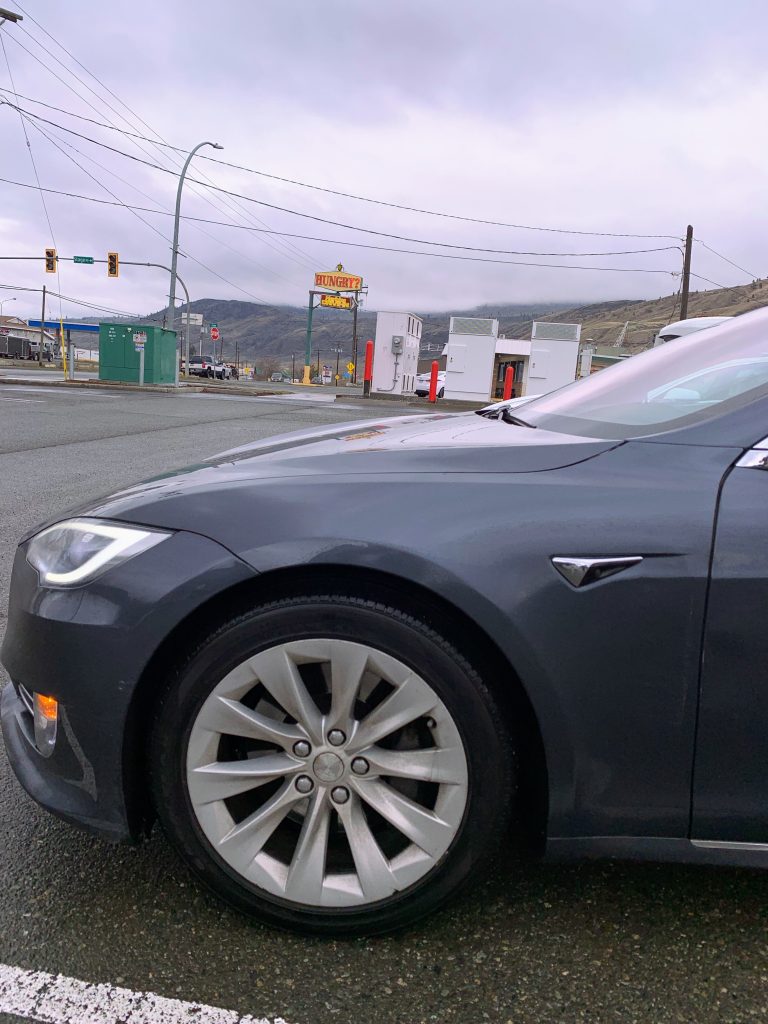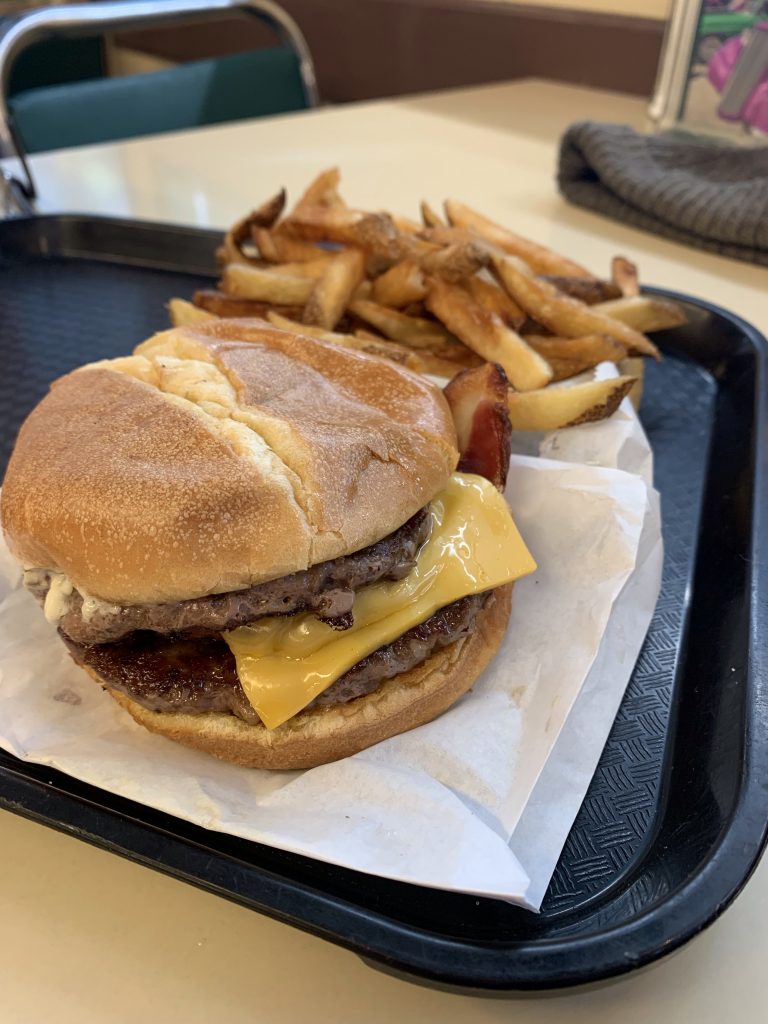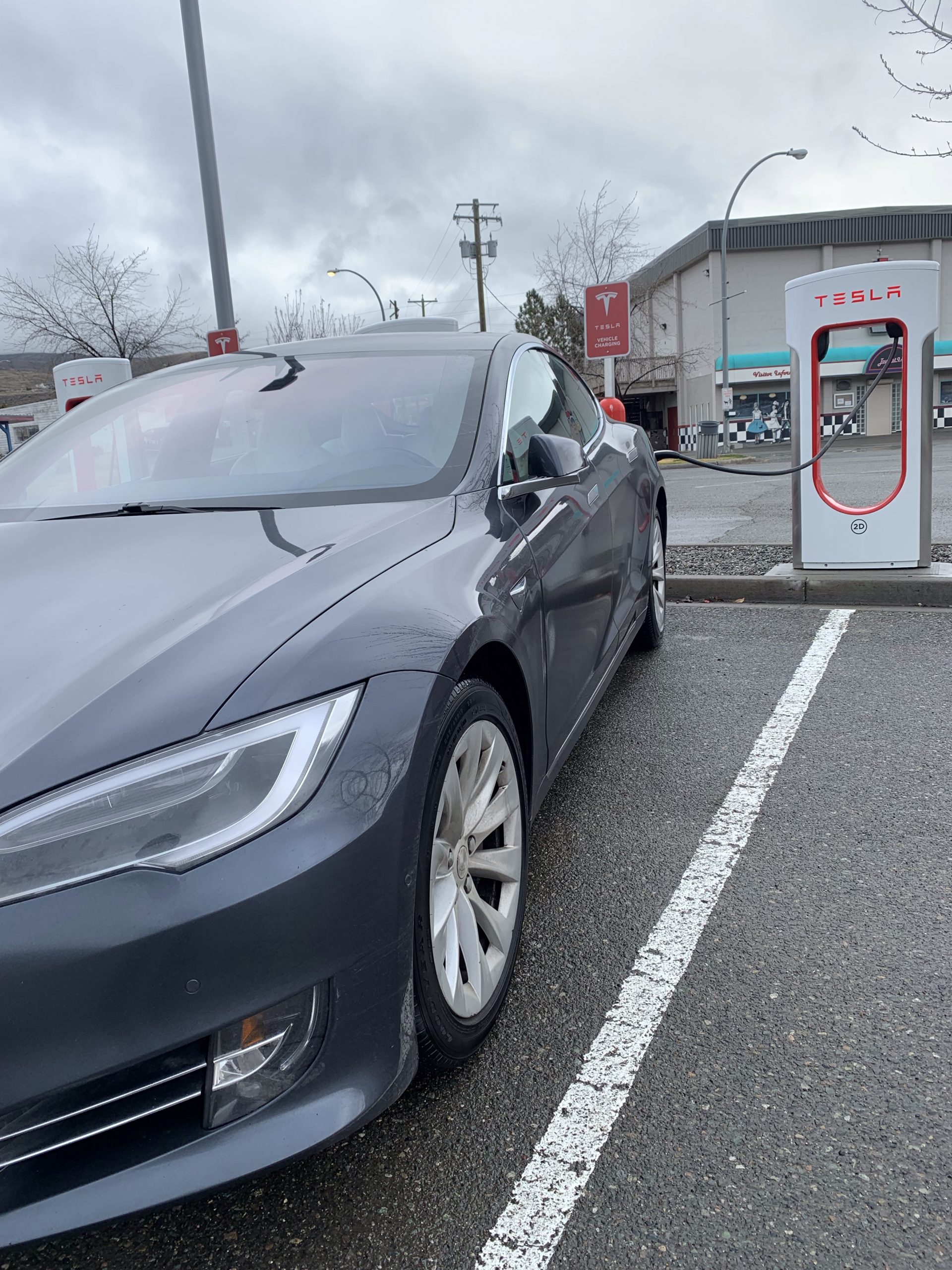I recently had the opportunity to go for an extended test drive in a Tesla Model S.
In case you don’t know, the Model S is the Tesla sedan. It is a four door car that reminded me of an old school Crown Victoria. It felt big, heavy, and secure on the road. The Model X is an SUV type of vehicle.
One funny thing about the Model S is that I found it awkward to get into the car. While I’m not a huge person, I just felt like I had to fold myself up and duck my head in an uncomfortable way to get in.
However, once I was in the car and sitting in the white leather seats it was very comfortable.
Now to look at some of the data or numbers. First off, this Model S, while it is about 5 years old, it had a 100 KWH battery – that’s the biggest capacity battery that Tesla sells.
The bigger the battery capacity, the more range – the longer distances you can drive before recharging. And that’s what we wanted to test out – how does the Model S hold up in a real world situation? How does it handle travel along Canadian highways in cool/cold weather?
So we left Burnaby late Saturday night and drove up the Trans Canada highway #1 to the Tesla supercharger station near Hope BC. A distance of about 130 kilometres. And let me add in here – I was NOT paying really close attention to the numbers – I was enjoying being a passenger in a car on my absolutely favourite highway. My numbers are the best estimations of what I recall.

We needed to get a significant charge in Hope because we didn’t have a charging cable with us and we were headed to Cache Creek – 190 kilometres away. Well, headed to Cache Creek with an overnight stop outside of Lytton.
The fact that we didn’t have a charging cord with us meant we could not plug the car in overnight while we were sleeping and we would need enough battery capacity to get to from Hope to Lytton and then on to the next Tesla supercharger station in Cache Creek.
When we got to Hope, we plugged the car in and then walked over to the convenience store located in the same parking lot. Because we were going so late in the evening, the Ricky’s Restaurant near the Tesla supercharger was closed. Instead of a meal we got a bag of potato chips and a ginger ale for our late night “dinner”.
By the time we’d finished using the washroom, choosing the chips and pop, and then eating them it had been about 25 minutes. We walked back to the car and saw that it had around 75% battery charge.
Cool thing is with the Tesla when you enter your destination in the navigation system it tells you approximately how much battery the car will have when you get to your destination.
Even though we were stopping for the night in Lytton we entered the destination as Cache Creek. The navigation system said we’d have about 25% battery capacity left when we got to Cache Creek.
But we knew that we were going to be messing with the actual plan. Fact – leaving a Tesla overnight in cold or hot weather can use up some of the battery capacity as the battery uses itself to keep itself at optimal temperature. This is part of our “real world” Canadian test of the Tesla.
As it turned out, in the morning when we checked the car, the battery still had plenty of charge for our trip up to Cache Creek.

Now here’s an interesting observation. Tesla has done a really good job of developing their charging infrastructure. Yes, as more people buy Teslas, they’ll need to expand the infrastructure. However, Tesla has already started building charging stations near services that travellers can use.
For example, the supercharger in Hope is beside a convenience store and restaurant. The supercharger in Cache Creek is right near three burger joints. That’s good planning! While the car chargers, we can eat. And when Tesla builds a supercharger station, they put in 12 or more chargers in each location. Building capacity.
On the other hand, the non-Tesla chargers are located in odd places that really do not make sense. In Boston Bar the non-Tesla chargers are on the side of a bowling alley. Nowhere near any other services.
Between Spences Bridge and Ashcroft at one of the rest stops there are a couple of FLO-chargers on the side of the highway – basically in the middle of nowhere. With NOTHING nearby for the driver or passengers to spend money on.
While Tesla is installing banks of ten or 12 chargers at a time, the other chargers are located in what I see as rather inconvenient spots and often there are only two chargers at a location. Compared to Tesla who is putting in 10 or 12 in each location.
It seems to me that someone in the Tesla office has looked at a map and has a master plan for where to put chargers so that Tesla drivers can travel with ease.
The non-Tesla chargers seem to be one-off random locations with no rationale for why they are located where they are.
Anyway, we got to Cache Creek with more than enough battery capacity to continue on to Kamloops without having to stop and charge, but me being new to the EV life, I insisted on stopping and charging the car. And of course the Tesla supercharger is located very close to Hungry Herbie’s so … burger time!

We ate our burgers (love the Herbie Burger and fries at Hungry Herbie’s!) and charged for less than half an hour before continuing our trip through Kamloops and down Highway 5A to Merritt (scenic route and a beautiful highway to drive!).
Again, the navigation system said we could have continued through Merritt and continued home down the Coquihalla but I wanted/needed to stretch my legs so we plugged into the supercharger in Merritt for 20-25 minutes.
Then we ripped down the Coquihalla – wow – the damage done in the November floods is unbelievable to see in real life!
We had dinner in Hope – we didn’t bother plugging in the car while we ate, and then back into the city. When I got out of the car at home it had 11% capacity remaining on the battery.
Impressions? The times we stopped to charge the Tesla were also times we needed to stop for ourselves – either to stretch, eat, or pee. Charging the car was not an inconvenience at all. Tesla has put a lot of thought into where to install supercharger stations – and it really works. Their chargers are located in convenient places with enough distance between charging stations and also with convenient services for the humans to nourish themselves at the same time.
I would say that the non-Tesla charging infrastructure while adequate, really does not appear to have the same “big, grandiose plan” thinking that Tesla has put into their systems.
Will I be buying a Tesla? Probably not. Actually, no, I will not because it is not in my budget. But I’m certainly impressed with the Model S and the charging infrastructure.
